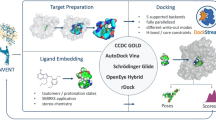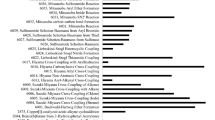Abstract
Pfizer Global Virtual Library (PGVL) of 1013 readily synthesizable molecules offers a tremendous opportunity for lead optimization and scaffold hopping in drug discovery projects. However, mining into a chemical space of this size presents a challenge for the concomitant design informatics due to the fact that standard molecular similarity searches against a collection of explicit molecules cannot be utilized, since no chemical information system could create and manage more than 108 explicit molecules. Nevertheless, by accepting a tolerable level of false negatives in search results, we were able to bypass the need for full 1013 enumeration and enabled the efficient similarity search and retrieval into this huge chemical space for practical usage by medicinal chemists. In this report, two search methods (LEAP1 and LEAP2) are presented. The first method uses PGVL reaction knowledge to disassemble the incoming search query molecule into a set of reactants and then uses reactant-level similarities into actual available starting materials to focus on a much smaller sub-region of the full virtual library compound space. This sub-region is then explicitly enumerated and searched via a standard similarity method using the original query molecule. The second method uses a fuzzy mapping onto candidate reactions and does not require exact disassembly of the incoming query molecule. Instead Basis Products (or capped reactants) are mapped into the query molecule and the resultant asymmetric similarity scores are used to prioritize the corresponding reactions and reactant sets. All sets of Basis Products are inherently indexed to specific reactions and specific starting materials. This again allows focusing on a much smaller sub-region for explicit enumeration and subsequent standard product-level similarity search. A set of validation studies were conducted. The results have shown that the level of false negatives for the disassembly-based method is acceptable when the query molecule can be recognized for exact disassembly, and the fuzzy reaction mapping method based on Basis Products has an even better performance in terms of lower false-negative rate because it is not limited by the requirement that the query molecule needs to be recognized by any disassembly algorithm. Both search methods have been implemented and accessed through a powerful desktop molecular design tool (see ref. (33) for details). The chapter will end with a comparison of published search methods against large virtual chemical space.
Access this chapter
Tax calculation will be finalised at checkout
Purchases are for personal use only
Similar content being viewed by others
References
Kola, I., Landis J. (2004) Can the pharmaceutical industry reduce attrition rates? Nat Rev Drug Discov 3, 711–715.
Milne, G. M. (2003) Pharmaceutical productivity: the imperative for new paradigms. Annu Rep Med Chem 38, 383–396.
Estep, K. (2004) File Enrichment and Hit Follow Up: Evolution and Examples. Poster Presentations at the ALA LabFusion.
Smith, G. F. (2006) Enabling HTS Hit follow-up via Chemo informatics, File Enrichment, and Outsourcing. High Throughput Medicinal Chemistry II; MMS Conferencing & Events Ltd., Institute of Physics; London. This article is also available on-line via this web link (http://www.mmsconferencing.com/pdf/htmc/g.smith.pdf).
Borman, S. (2006) Improving efficiency. To eliminate R&D bottlenecks, drug companies are evaluating all phases of discovery and development and are using novel approaches to speed them up. Chem Eng News 84, 56–78.
Peng, Z., Yang, B., Mattaparti, S., Shulok, T., Thacher, T., Kong, J., Kostrowicki, J., Hu, Q., Na, J., Zhou, J. Z., Klatte, K., Chao, B., Ito, S., Clark, J., Coner, C., Waller, C., Kuki, A. (2010) PGVL Hub: an integrated desktop tool for medicinal chemists to streamline design and synthesis of chemical libraries and singleton compounds. Chemical Library Design, in (Zhou, J. Z., ed.), Humana Press, New York, NY.
Nikitin, S., Zaitseva, N., Demina, O., Solovieva, V., Mazin, E., Mikhalev, S., Smolov, M., Rubinov, A., Vlasov, P., Lepikhin, D., Khachko, D., Fokin, V., Queen, C., Zosimov, V. (2005) A very large diversity space of synthetically accessible compounds for use with drug design programs. J Comput Aided Mol Design 19, 47–63.
Chemical Abstract Service: http://www.cas.org/, under substances count
Pubchem: http://www.ncbi.nlm.nih.gov/sites/entrez?cmd=search&db=pccompound&term=all[filt].
Andrews, K. M., Cramer, R. D. (2000) Toward general methods of targeted library design: topomer shape similarity searching with diverse structures as queries. J Med Chem 43, 1723–1740.
Hu, Q., Kostrowicki, J., Peng, Z., Kuki, A. (2008) LEAP into the Pfizer Global Virtual Library (PGVL) space – creation of the readily synthesizable design ideas automatically, Scitegic Pipeline Pilot User Group Meeting, San Diego, CA.
Cramer, R.D., Soltanshahi, F., Jilek, R., Campbell, B. (2007) AllChem: generating and searching 1020 synthetically accessible structures. J Comput Aided Mol Des 21, 341–350.
Rarey, M., Stahl, M. (2001) Similarity searching in large combinatorial chemistry spaces. J Comput Aided Mol Des 15, 497–520.
Yu, N., Bakken, G. A. (2009) Efficient exploration of large combinatorial chemistry spaces by monomer-based similarity searching. J Chem Inf Model 49, 745–755.
Lessel, U., Wellenzohn, B., Lilienthal, M., Claussen, H. (2009) Searching fragment spaces with feature trees. J Chem Inf Model 49, 270–279.
Boehm, M. Wu, T., Claussen, H., Lemmen, C. (2008) Similarity searching and scaffold hopping in synthetically accessible combinatorial chemistry spaces. J Med Chem 51, 2468–2480.
Chen, X., Reynolds, C. H. (2002) Performance of similarity measures in 2D fragment-based similarity searching: comparison of structural descriptors and similarity coefficients. J Chem Inf Comput Sci 42, 1407–1414.
Pipeline Pilot from SciTegic: http://www.scitegic.com/
Shi, S., Peng, Z., Kostrowicki, J., Paderes, G., Kuki A. (2000) “Efficient combinatorial filtering for desired molecular properties of reaction products”. J Mol Graph Model 18, 478–496.
Zhou, Z., Shi, S., Na, J., Peng, Z., Thacher, T. (2009) Combinatorial library-based design with basis products. J Comput Aided Mol Des 23, 725–736.
Lau, W., Hepworth, D., Magee, T., Du, J., Bakken, G., Miller, M., Hendsch, Z., Thanabal, V., Kolodziej, S., Xing, L., Hu, Q., Narasimhan, L., Love, R., Charlton, M., Hughes, S., Van Hoorn, W., Mills, J., Withka, J. (2010) Design of a multi-purpose fragment screening library using molecular complexity and orthogonal diversity metrics. J Comput-Aided Mol Des.
Tversky, A. (1977) Features of similarity. Psycholog Rev 84, 327–352.
Bradshaw, J. (1997) Introduction to the Tversky Similarity Measure. Presented at Daylight MUG Meeting, Laguna Beach, CA, URL http://www.daylight.com/meetings/mug97/agenda97/Bradshaw/MUG97/tv¥tversky.html.
Durant, J. L., Leland, B. A., Henry, D. R., Nourse, J. G. (2002) Reoptimization of MDL keys for use in drug discovery. J Chem Inf Comput Sci 42, 1273–1280.
ISIS host from Symyx: http://www.symyx.com/products/software/cheminformatics/isis-host/index.jsp
Qu, D., Ludwig, D.S., Gammeltoft, S. et al. (1996) A role for melanin-concentrating hormone in the central regulation of feeding behavior. Nature 380, 243–247.
Saito, Y., Nothacker, H., Wang, Z., et al. (1999) Molecular characterization of the melanin-concentrating hormone receptor. Nature 400, 265–269.
Li, H., Sutter, J., Hoffmann, R. (2000) HypoGen: an automated system for generating predictive 3D Pharmacophore Models. Pharmacophore Perception, Development, and use in Drug Design,in (Güner, O. F., ed.), International University Line, La Jolla, CA.
Nachmias, B., Ashhab, Y., Ben-Yehuda, D. (2004) The inhibitor of apoptosis protein family (IAPs): an emerging therapeutic target in cancer. Semin Cancer Biol 14, 231–243.
Schimmer, A. D., Dalili, S., Riedl, S. J. (2006) Targeting XIAP for the treatment of malignancy. Cell Death Different 13, 179–188.
Putt, K. S., Chen, G. W., Pearson, J. M., Sandhorst, J. S., Hoagland, M. S., Kwon, J. T., Hwang, S. K., Jin, H., Churchwell, M. I., Cho, M. H., Doerge, D. R., Helferich, W. G., Hergenrother, P. J. (2006) Small molecule activation of procaspase-3 to Caspase-3 as a personalized anti-cancer strategy. Nat Chem Biol 2, 543–550.
Lewell, X. Q., Judd, D. B., Watson, S. P., Hann, M. M. (1998) RECAP—retrosynthetic combinatorial analysis procedure: a powerful new technique for identifying privileged molecular fragments with useful applications in combinatorial chemistry. J Chem Inf Comput Sci 38, 511–522.
Peng, Z., Yang, B., Mattaparti, S., Shulok, T., Thacher, T., Kong, J., Kostrowicki, J., Hu, Q., Na, J., Zhou, J. Z., Klatte, K., Chao, B., Ito, S., Clark, J., Coner, C., Waller, C., Kuki, A. (2011) PGVL Hub: an integrated desktop tool for medicinal chemists to streamline design and synthesis of chemical libraries and singleton compounds, in (Zhou, J. Z. ed.) Chemical Library Design. Humana Press, New York, Chapter 15.
Acknowledgments
The authors would like to thank the following Pfizer colleagues for their generous help and support: Bo Yang, Thom Shulok, Sarathy Mattaparti, Bo Chao, Tom Thacher, and Joe Zhou (for their work on the PGVL software and its reaction and starting material data foundation which enabled the development and deployment of LEAP1/2); Bob McDonough, Zi Yang, and Da Tse (for informatics support); and Gigi Paderes, Klaus Dress, Dilip Bhumralkar, and Michele Ramirez-Weinhouse (for being the early adopters of LEAP1/2 and applying them vigorously in their drug discovery projects); Ben Burke and Zhongxiang (Joe) Zhou for their valuable comments, suggestions, and proof reading the draft. We also appreciate the technical support from Derek Stonich and Anne Li-Zhong of SciTegic/Accelrys.
Author information
Authors and Affiliations
Editor information
Editors and Affiliations
Rights and permissions
Copyright information
© 2011 Springer-Science+Business Media, LLC
About this protocol
Cite this protocol
Hu, Q., Peng, Z., Kostrowicki, J., Kuki, A. (2011). LEAP into the Pfizer Global Virtual Library (PGVL) Space: Creation of Readily Synthesizable Design Ideas Automatically. In: Zhou, J. (eds) Chemical Library Design. Methods in Molecular Biology, vol 685. Humana Press. https://doi.org/10.1007/978-1-60761-931-4_13
Download citation
DOI: https://doi.org/10.1007/978-1-60761-931-4_13
Published:
Publisher Name: Humana Press
Print ISBN: 978-1-60761-930-7
Online ISBN: 978-1-60761-931-4
eBook Packages: Springer Protocols




